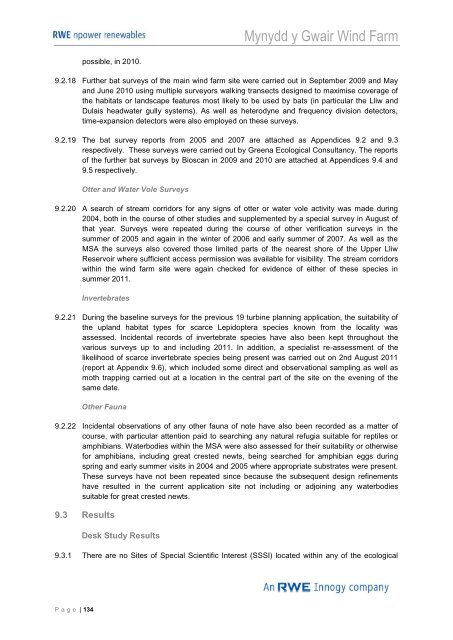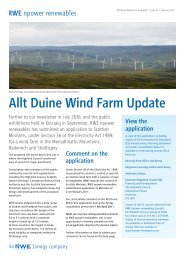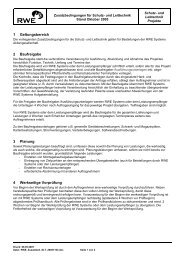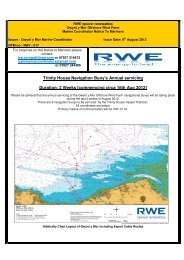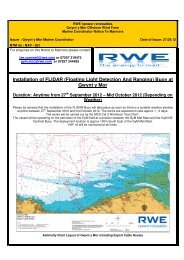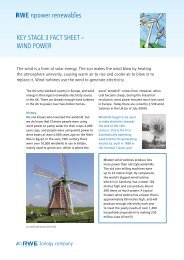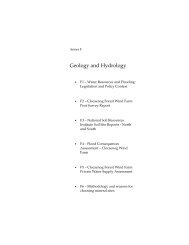Mynydd y Gwair Wind Farm - RWE.com
Mynydd y Gwair Wind Farm - RWE.com
Mynydd y Gwair Wind Farm - RWE.com
Create successful ePaper yourself
Turn your PDF publications into a flip-book with our unique Google optimized e-Paper software.
P a g e | 134<br />
possible, in 2010.<br />
<strong>Mynydd</strong> y <strong>Gwair</strong> <strong>Wind</strong> <strong>Farm</strong><br />
9.2.18 Further bat surveys of the main wind farm site were carried out in September 2009 and May<br />
and June 2010 using multiple surveyors walking transects designed to maximise coverage of<br />
the habitats or landscape features most likely to be used by bats (in particular the Lliw and<br />
Dulais headwater gully systems). As well as heterodyne and frequency division detectors,<br />
time-expansion detectors were also employed on these surveys.<br />
9.2.19 The bat survey reports from 2005 and 2007 are attached as Appendices 9.2 and 9.3<br />
respectively. These surveys were carried out by Greena Ecological Consultancy. The reports<br />
of the further bat surveys by Bioscan in 2009 and 2010 are attached at Appendices 9.4 and<br />
9.5 respectively.<br />
Otter and Water Vole Surveys<br />
9.2.20 A search of stream corridors for any signs of otter or water vole activity was made during<br />
2004, both in the course of other studies and supplemented by a special survey in August of<br />
that year. Surveys were repeated during the course of other verification surveys in the<br />
summer of 2005 and again in the winter of 2006 and early summer of 2007. As well as the<br />
MSA the surveys also covered those limited parts of the nearest shore of the Upper Lliw<br />
Reservoir where sufficient access permission was available for visibility. The stream corridors<br />
within the wind farm site were again checked for evidence of either of these species in<br />
summer 2011.<br />
Invertebrates<br />
9.2.21 During the baseline surveys for the previous 19 turbine planning application, the suitability of<br />
the upland habitat types for scarce Lepidoptera species known from the locality was<br />
assessed. Incidental records of invertebrate species have also been kept throughout the<br />
various surveys up to and including 2011. In addition, a specialist re-assessment of the<br />
likelihood of scarce invertebrate species being present was carried out on 2nd August 2011<br />
(report at Appendix 9.6), which included some direct and observational sampling as well as<br />
moth trapping carried out at a location in the central part of the site on the evening of the<br />
same date.<br />
Other Fauna<br />
9.2.22 Incidental observations of any other fauna of note have also been recorded as a matter of<br />
course, with particular attention paid to searching any natural refugia suitable for reptiles or<br />
amphibians. Waterbodies within the MSA were also assessed for their suitability or otherwise<br />
for amphibians, including great crested newts, being searched for amphibian eggs during<br />
spring and early summer visits in 2004 and 2005 where appropriate substrates were present.<br />
These surveys have not been repeated since because the subsequent design refinements<br />
have resulted in the current application site not including or adjoining any waterbodies<br />
suitable for great crested newts.<br />
9.3 Results<br />
Desk Study Results<br />
9.3.1 There are no Sites of Special Scientific Interest (SSSI) located within any of the ecological


